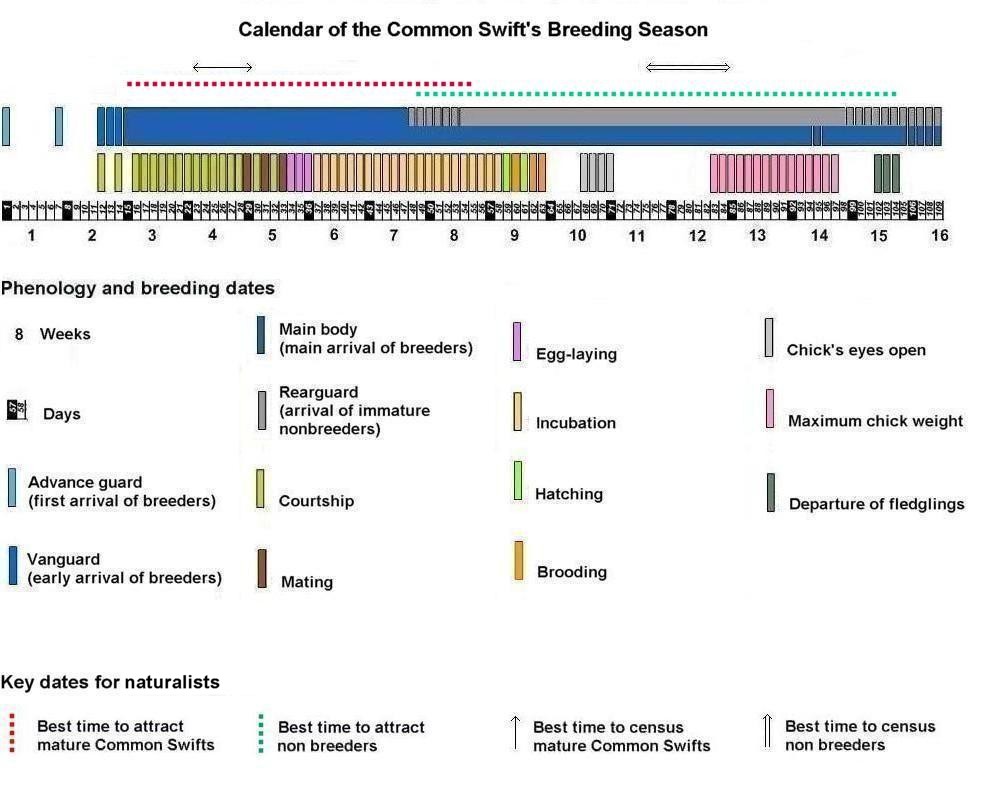
|
|
The Common Swift calendar
|
|
A comparison of the dates for the arrival and departure of the Common Swift in summer showed that the species stays about 109 days in the breeding areas, and about 95 days on the nest. The stay seems to lengthen slightly by a not yet known factor from north to south. I created a calendar for the Common Swift, which is valid for most parts of the breeding range, and which can be used for orientation in the complete summer breeding area.
All the key data (arrival, egg-laying, incubation, hatching, brooding, fledging and departure of adults) are exclusively median values. A median is the value in the middle, and is used when there are no mathematical parameters, such as date specifications. The mathematical data need not necessarily coincide with median dates.
The Common Swifts arrives in four waves. The non breeders may leave before the breeders or together with them. The Swifts usually lays two to three eggs with an interval of two days from each egg. Breeding starts after the last egg is laid. The hatching starts after 19 days in average. (The difference of the median values here is 23 days.) Swifts feed exclusively on airborne insects. When the weather turns cold, the food supply diminishes or even disappears. This is why the young Swift has evolved to develop a high body mass (weight). It serves as a reserve for periods of bad weather when there is little or no food to be had. Before flying out, the young Swift's weight decreases to its normal or flight weight.
The calendar may be used anywhere in the summer range, except possibly within northern Lapland. If one knows the arrival or departure date in a given location, one can quickly find out, by using the calendar, what the Common Swift is doing just now.
Usually one knows the date of the arrival of the Main Body. Here are some arrival dates. Jerusalem 20.2. Advance Guard, Tel Aviv 19.2. Advance Guard, 6.3. Main Body, Teheran 11.3., Peking 12.4., Moscow 12.5., Irkutsk Region, 21.5., Madrid 12.4. Advance Guard, 25.4. Main Body, Berlin, 24.4. Advance Guard, 8.5. Main Body, Erzurum 29.4., Forlì 9.4., Tulchin 12.5., Cherkasy 1.5., Simbirsk 9.5., Ivanovo 19.5., St. Peterburg 18.5., Helsinki 27.5. (If you want to know the sources, please send me an e-mail.)
You find more arrival dates here: http://www.commonswift.org/arrival.html
Details about how to attract the Common Swifts are here: http://www.commonswift.org/Attracting-Common-Swifts.html and details about how to count Swifts are here: http://www.commonswift.org/census.html.
Further information on this topic: Tigges, U. (2006): The Breeding Cycle in Calendar Form of the Common Swift Apus apus across its Eurasian Breeding Range - A Testable Hypothesis? Podoces 01: 27-33, APUSlist No. 3224 |
Commonswift Worldwide © Ulrich Tigges
Apus apus, Swifts, Commonswift, gierzwaluw, vencejo comun, sis hachomot, סיס החומות, Црна чиопа, Kara Sağan, Čiopa, ciopa, chyorny strizh, Gierzwaluw (Apus apus), Vencejo común, Черный Стриж, Martinet noir, Rondone comune, rondoni, åtactara, السمامة, Mauersegler, Apuslife
Commonswift's topography, togography of the Commonswift, feathers, crown, eye line, eye patch, forecrown, lore, chin, throat, ear coverts, hindneck, mantle, scapulars, rump, uppertail coverts, tail, tertials, greater coverts, secondaries, median coverts, leading edge coverts, lesser coverts, lesser primary coverts, alula, median primary coverts, leading edge coverts, greater primary coverts, primaries, median coverts, greater coverts, secondaries, axillaries, undertail, undertail coverts, rear flank, vent, flank, belly, brest, apodidae, apodiformes, size, color, colour, weight, sex, flight acquaintance, flight speed, age, food, enemies, pair bonding, nest, eggs, egg, young, bad weather, voice, download wave file, survive, survival, colony, flying insects
